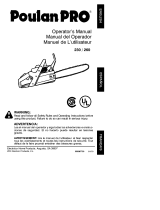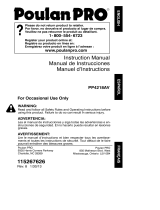
YOUR WARRANTY RIGHTS AND OB-
LIGATIONS: The U. S. Environmental
Protection Agenc3y,,Environment Canada
and ELECTROLUX HOME PRODUCTS,
INC., are pleased to explain the emissions
control system warranty on your year
2002-2004 small off-road engine. ELEC-
TROLUX HOME PRODUCTS, INC., must
warrant theemission control system onyour
small off- road engine for the periods of time
listed below provided there has been no
abuse, neglect, or improper maintenance of
your small off-road engine. Your emission
control system includes parts such as the
carburetor and the ignition system. Where a
warrantable condition exists, ELECTRO-
LUX HOME PRODUCTS, INC., will repair
your smatl off-road engine atno cost to you.
Expenses covered under warranty include
diagnosis, parts and labor. MANUFACTUR-
ER'S WARRANTY COVERAGE: If any
emissions related part on your engine (as
listed under Emissions Control Warranty
Parts List is defective or adefect in the ma-
ter a s or workmansh p ofthe eng necauses
the failure of such an emission related part,
the part will be repaired or replaced by
ELECTROLUX HOME PRODUCTS, INC.
OWNER'S WARRANTY RESPONSIBILI-
TIES: As the small off-road engine owner,
you are responsible for the performanceof
the required maintenance listed in your in-
struction manual. ELECTROLUX HOME
PRODUCTS, INC.+recommends that you
retain all receipts covering maintenance on
your small off-toed engine, but ELECTRO-
LUX HOME PRODUCTS, INC., cannot
deny warranty solely for thelack of receipts
or for your failure 1oensure the performance
of all scheduled maintenance. As thesmall
off-roed engine owner, you should beaware
that ELECTROLUX HOME PRODUCTS,
INC., may deny you warranty coverage if
our small off-road engine or a part of it has
_aileddue to abuse, neglect, improper main-
tenance, unapproved modifications, or the
use of parts not made or approved by the
original equipment manufacture_ You are
responsible for presentinngyour small off-
road engine to an ELECTROLUX HOME
PRODUCTS, INC.+authorized repair center
as soon as a problem exists. Warranty re-
pairs should be completed in a reasonable
amount oftime, nottoexceed 30days. Ifyou
have any questions regarding your warranty
rights and responsibilities, you should con-
tact your nearest authorized service center
or call ELECTROLUX HOME PRODUCTS+
INC., at 1-800-554-6723. WARRANTY
COMMENCEMENT DATE: The warranty
period begins onthe date the small off-road
engine is purchased. LENGTH OFCOVER-
AGE: This warranty shall be for a periodof
two years from the initial date of purchase.
WHAT IS COVERED: REPAIR OR RE-
PLACEMENT OF PARTS. Repair or re-
placement of any warranted part will be per-
formed at no charge to the owner at an
approved ELECTROLUX HOME PROD-
UCTS, INC., servicing center. If you have
any questions regarding your warranty
rights and responsibilities, you should con-
tact your nearest authorized service center
or call ELECTROLUX HOME PRODUCTS,
INC., at 1-800-554-6723. WARRANTY
PERIOD: Any warranted part which is not
scheduled for replacement as required
maintenance, or which is scheduled only for
regular inspection to the effect of "repair or
replace as necessary" shall bewarranted for
2years. Any warranted part which is sched-
uled for replacement as required mainte-
nance shall be warranted for the period of
time up to the first scheduled replacement
point for that part. DIAGNOSIS: The owner
shall not be charged for diagnostic labor
which leads to the determination that awar-
ranted part isdefective if thediagnostic work
is performed at anapproved ELECTROLUX
HOME PRODUCTS, INC., servicing center.
CONSEQUENTIAL DAMAGES: ELEC-
TROLUX HOME PRODUCTS, INC., may
be liable for damages to other engine com-
ponents caused by thefailure ofawarranted
part still under warranty. WHAT IS NOT
COVERED: All failures caused by abuse,
neglect, or improper maintenance are not
covered. ADD-ON OR MODIFIED PARTS:
The use of add-on or modified parts can be
grounds for disallowing a warranty claim.
ELECTROLUX HOME PRODUCTS, INC.,
is not liable to cover failures of warranted
parts caused by the use of add-on or modi-
fied parts. HOW TO FILE A CLAIM: Ifyou
have any questions regarding your warranty
rights and responsibilities, you should con-
tact your nearest authorized service center
or call ELECTROLUX HOME PRODUCTS,
INC., at 1-800-554-6723.WHERE TO GET
WARRANTY SERVICE: Warranty services
or repairs shall beprovided at all ELECTRO*
LUX HOME PRODUCTS, INC., service
centers. Call 1-800-554-8723. MAINTE-
NANCE, REPLACEMENT AND REPAIR
OF EMISSION RELATED PARTS: Any
ELECTROLUX HOME PRODUCTS, INC.+
approved replacement part used in the per-
formance of any warranty maintenance or
repair on emission related parts will be pro-
vided without charge to the owner if the part
is under warranty. EMISSION CONTROL
WARRANTY PARTS LIST: Carburetor,
ignition System: Spark Plug (covered up to
maintenance schedule), ignition Module.
MAINTENANCE STATEMENT: The owner
is responsible for the performance of all re-
quffed maintenance as defined in the in-
struction manual.
17






















